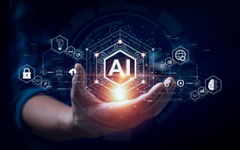 Would it surprise you to learn that 82 percent of companies are currently using or exploring artificial intelligence (AI) in their operations? Further, 84 percent report they are increasing their investments in data and AI.[1] That’s because AI has a near limitless capability to aid businesses and organizations in their effort to help boost energy efficiency, reduce carbon emissions, support clean energy technologies, and address climate change. Here are three specific ways AI is driving energy efficiency.
Would it surprise you to learn that 82 percent of companies are currently using or exploring artificial intelligence (AI) in their operations? Further, 84 percent report they are increasing their investments in data and AI.[1] That’s because AI has a near limitless capability to aid businesses and organizations in their effort to help boost energy efficiency, reduce carbon emissions, support clean energy technologies, and address climate change. Here are three specific ways AI is driving energy efficiency.
Enabling a More Efficient Electric Grid
The power grid is becoming more complex as more renewable energy sources come online. Large power plants used to supply energy to American homes almost exclusively, but now millions of solar panels generate variable electricity. Add unpredictable weather, and it can be challenging to balance demand with supply. To manage all of these variables, grid operators are turning to AI.
Researchers at MIT recently reported four ways that AI is making the power grid faster and more resilient, including allowing for:
- Faster and better decision making – helping grid operators to understand current conditions, make better decisions, and predict potential problems.
- A tailored approach to every home – Lunar Energy, a battery and grid-technology startup, is using AI to help its customers optimize their energy use and save money.
- Making electric vehicles (EVs) work with the grid – The adoption of EVs adds significant energy demand. Companies like WeaveGrid collaborate with utility companies, automakers, and charging companies to collect and analyze EV charging data to determine optimal charging times and make recommendations to customers via text messages or app notifications about when to charge their vehicles.
- Spotting disasters before they hit – Several utility companies, including PG&E in Northern and Central California, have begun integrating AI into critical operations, including inspecting and managing physical infrastructure, such as transmission lines and transformers. Before this, manual inspections were common but could take months. By analyzing photographs taken using drones and helicopters, AI models can identify areas requiring tree trimming or find faulty equipment.
Even with the advances in AI for grid operations, experts say that power delivery will still require human operators. Though AI use will expand, strict protocols are used to avoid mistakes in critical decisions.
Boosting Energy Efficiency and Sustainability in Manufacturing
Manufacturing facilities are leveraging AI to decarbonize the products they produce, cut waste, and control energy use, according to the Industrial Decarbonization Network.[2]
AI is powering more sustainable choices to use in manufacturing, helping companies find impactful decarbonization opportunities. At the state and federal levels, decarbonization mandates are driving much of this change, and this will only accelerate. As AI is deployed as a tool in the toolbox of decarbonization, manufacturers will reap the benefits. In fact, consultants at BCG estimate that $1.3 trillion to $2.6 trillion in value can be generated by applying AI to corporate sustainability efforts.
Improving Logistics Operations
AI is being used to optimize transportation systems and reduce carbon emissions in industries. Route planning, transportation management, and fleet optimization review traffic conditions, fuel consumption, and alternative routes to assess how to optimize the delivery of products.
AI can also support the deployment of self-driving vehicles, which can be designed to be more energy efficient and limit carbon emissions.
The Star of the Show is Smart Grid Management
Smart grid management is arguably the most compelling benefit of using AI to achieve energy efficiency. It allows utilities to monitor and control the flow of electricity in real-time. Coupled with renewable energy sources, energy storage systems, and demand response, AI has the capability to radically transform the balance of supply and demand, increasing overall utility reliability.
And though AI’s benefits can’t be denied, it has faced its energy use critics.
Concerns About Energy Use and AI
A long-standing criticism of the use of digital technologies like AI has been that they will become increasingly more energy-intensive. Furthermore, with the recent surge in AI deployment, critics are again raising concerns about the technology’s energy use. However, a new report from the Information Technology and Innovation Foundation finds that concerns about the spiraling energy use required for AI are overblown. This conclusion is supported by the fact that according to the International Agency (IEA), today’s data centers and data transmission networks that power AI each account for about 1-1.5% of global electricity use – a very small number.
Conclusion
As the use of AI grows, there are many ways that it can benefit global energy efficiency and the building industry in particular.
How do you see the advance of AI benefiting the building industry, insulation installers, manufacturers, or operations? Let us know with a comment.
[1] https://blogs.nvidia.com/blog/energy-efficient-ai-industries/
[2] https://www.industrialdecarbonizationnetwork.com/sustainability-data-analytics/articles/8-ways-artificial-intelligence-can-drive-decarbonization#:~:text=Building%20energy%20management%3A%20AI%20can,reduction%20in%20the%20built%20environment.





